seats AUDI R8 SPYDER 2014 User Guide
[x] Cancel search | Manufacturer: AUDI, Model Year: 2014, Model line: R8 SPYDER, Model: AUDI R8 SPYDER 2014Pages: 244, PDF Size: 61.06 MB
Page 97 of 244
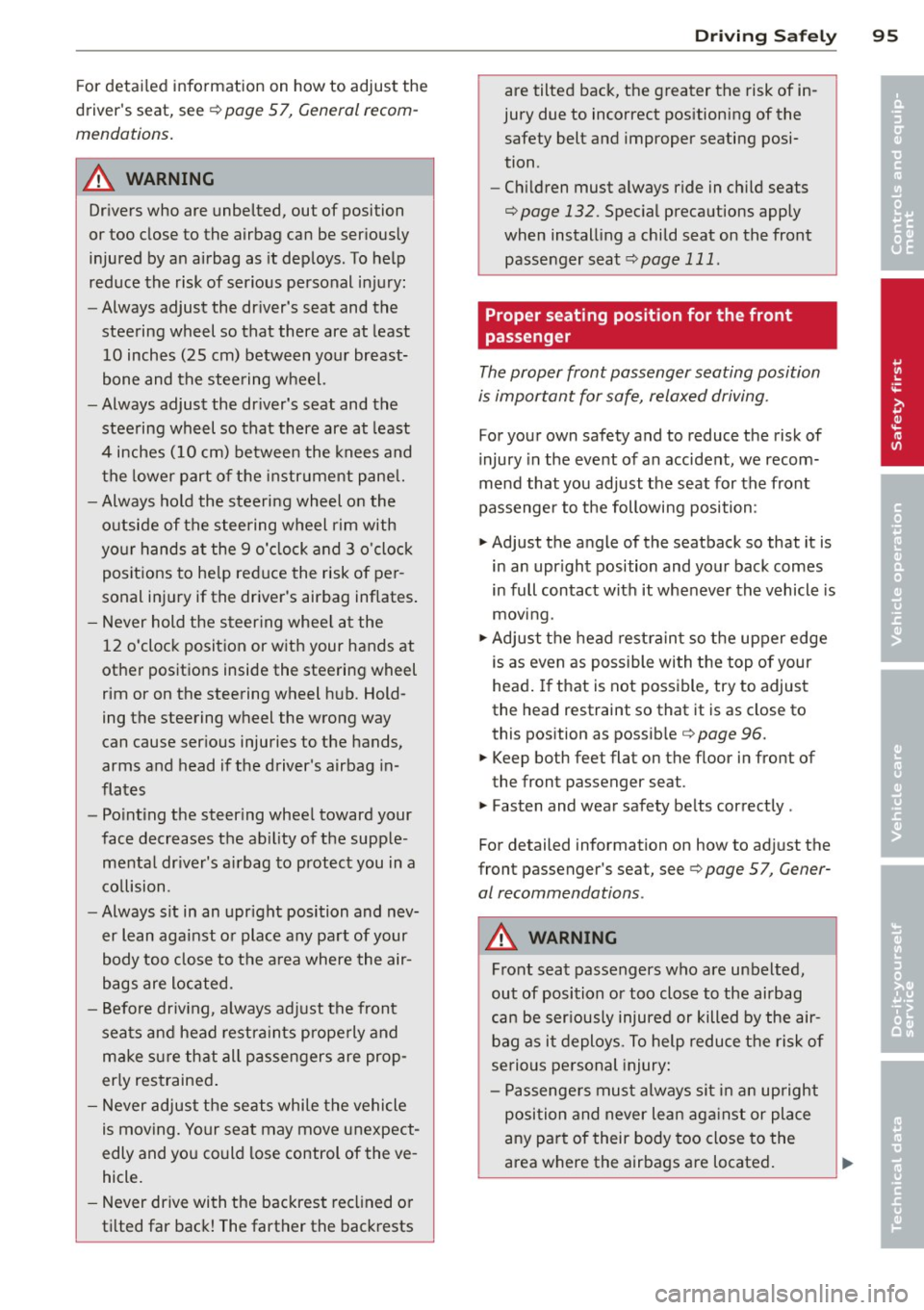
For detailed information on how to adjust the
driver's seat, see ¢
page 5 7, General recom
mendations.
A WARNING
Drivers who are unbelted, out of position
or too close to the airbag can be seriously
injured by an airbag as it deploys. To help
reduce the risk of serious personal injury:
- Always adjust the driver's seat and the
steering wheel so that there are at least
10 inches (25 cm) between your breast
bone and the steering wheel.
- Always adjust the driver's seat and the
steering wheel so that there are at least
4 inches (10 cm) between the knees and
the lower part of the instrument panel.
- Always hold the steering wheel on the
outside of the steering wheel rim with
your hands at the 9 o'clock and 3 o'clock
positions to help reduce the risk of per
sonal injury if the driver's airbag inflates.
- Never hold the steering wheel at the
12 o'clock position or with your hands at
other positions inside the steering wheel
rim or on the steering wheel hub. Hold
ing the steering wheel the wrong way
can cause serious injuries to the hands,
arms and head if the driver's airbag in
flates
- Pointing the steering wheel toward your
face decreases the ability of the supple mental driver's airbag to protect you in a
collision.
-Always sit in an upright position and nev
er lean against or place any part of your
body too close to the area where the air
bags are located.
- Before driving, always adjust the front
seats and head restraints properly and
make sure that all passengers are prop
erly restrained.
- Never adjust the seats while the vehicle
is moving. Your seat may move unexpect
edly and you could lose control of the ve
hicle.
- Never drive with the backrest reclined or
tilted far back! The farther the backrests
Driving Safely 95
are tilted back, the greater the risk of in
jury due to incorrect positioning of the
safety belt and improper seating posi
tion .
- Children must always ride in child seats
¢
page 132 . Special precautions apply
when installing a child seat on the front
passenger seat¢
page 111.
Proper seating position for the front
passenger
The proper front passenger seating position
is important for safe, relaxed driving.
For your own safety and to reduce the risk of
injury in the event of an accident, we recom
mend that you adjust the seat for the front
passenger to the following position:
"'Adjust the angle of the seatback so that it is
in an upright position and your back comes
in full contact with it whenever the vehicle is
moving.
"'Adjust the head restraint so the upper edge
is as even as possible with the top of your
head. If that is not possible, try to adjust
the head restraint
so that it is as close to
this position as possible ¢
page 96.
"' Keep both feet flat on the floor in front of
the front passenger seat.
"' Fasten and wear safety belts correctly .
For detailed information on how to adjust the
front passenger's seat, see ¢
page 5 7, Gener
al recommendations .
A WARNING
Front seat passengers who are unbelted,
out of position or too close to the airbag
can be seriously injured or killed by the air
bag as it deploys. To help reduce the risk of
serious personal injury:
- Passengers must always sit in an upright
position and never lean against or place
any part of their body too close to the
area where the airbags are located.
-
•
•
Page 98 of 244
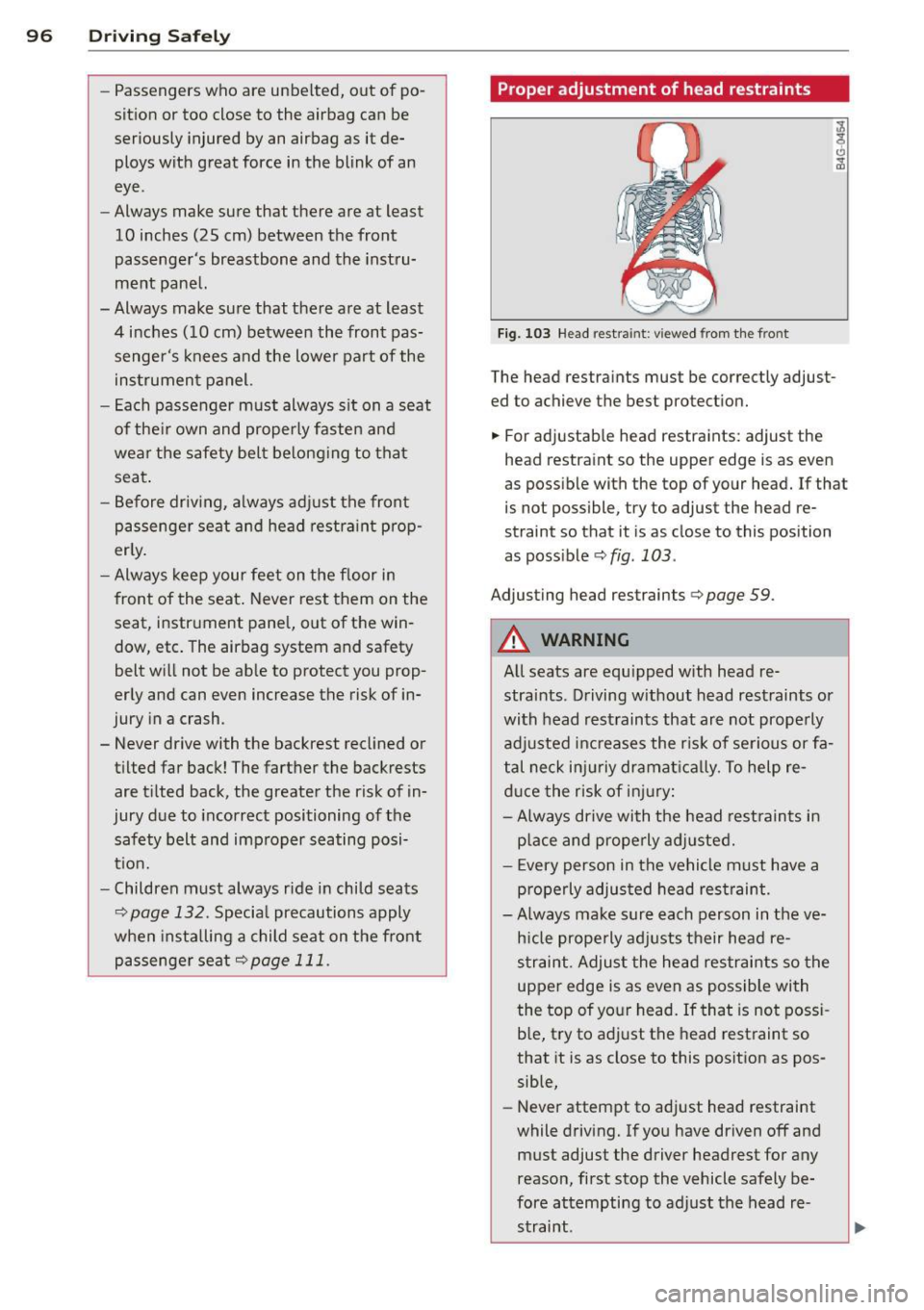
96 Driving Safely
-Passengers who are unbelted, out of po
sition or too close to the airbag can be
seriously injured by an airbag as it de
ploys with great force in the blink of an
eye.
- Always make sure that there are at least
10 inches (25 cm) between the front
passenger's breastbone and the instru
ment panel.
- Always make sure that there are at least
4 inches (10 cm) between the front pas
senger's knees and the lower part of the
instrument panel.
- Each passenger must always sit on a seat
of their own and properly fasten and
wear the safety belt belonging to that
seat.
- Before driving, always adjust the front
passenger seat and head restraint prop
erly.
- Always keep your feet on the floor in
front of the seat . Never rest them on the
seat, instrument panel, out of the win
dow, etc. The airbag system and safety
belt will not be able to protect you prop
erly and can even increase the risk of in
jury in a crash.
- Never drive with the backrest reclined or
tilted far back! The farther the backrests
are tilted back, the greater the risk of in
jury due to incorrect positioning of the
safety belt and improper seating posi
tion.
- Children must always ride in child seats
¢page 132. Special precautions apply
when installing a child seat on the front
passenger seat
r:::;, page 111.
Proper adjustment of head restraints
Fig. 103 Head restra int: v iewed from the front
The head restraints must be correctly adjust
ed to achieve the best protection.
.,. For adjustable head restraints: adjust the
head restraint so the upper edge is as even
as possible with the top of your head. If that
is not possible, try to adjust the head re
straint so that it is as close to this position
as possible
r:::;, fig. 103 .
Adjusting head restraints¢
page 59.
A WARNING ~
All seats are equipped with head re-
straints. Driving w ithout head restraints or
with head restraints that are not properly
adjusted increases the risk of serious or fa
tal neck injuriy dramat ically. To help re
duce the risk of injury:
- Always drive with the head restraints in
p la ce and properly adjusted.
- Every person in the vehicle must have a
properly adjusted head restraint.
- Always make sure each person in the ve
h icle properly adjusts their head re
straint. Adjust the head restraints so the
upper edge is as even as possible with
the top of your head. If that is not possi
ble, try to adjust the head restraint so
that it is as close to this position as pos
sible,
- Never attempt to adjust head restraint
while driving. If you have driven off and must adjust the driver headrest for any
reason, first stop the vehicle safely be
fore attempting to adjust the head re
straint .
Page 99 of 244
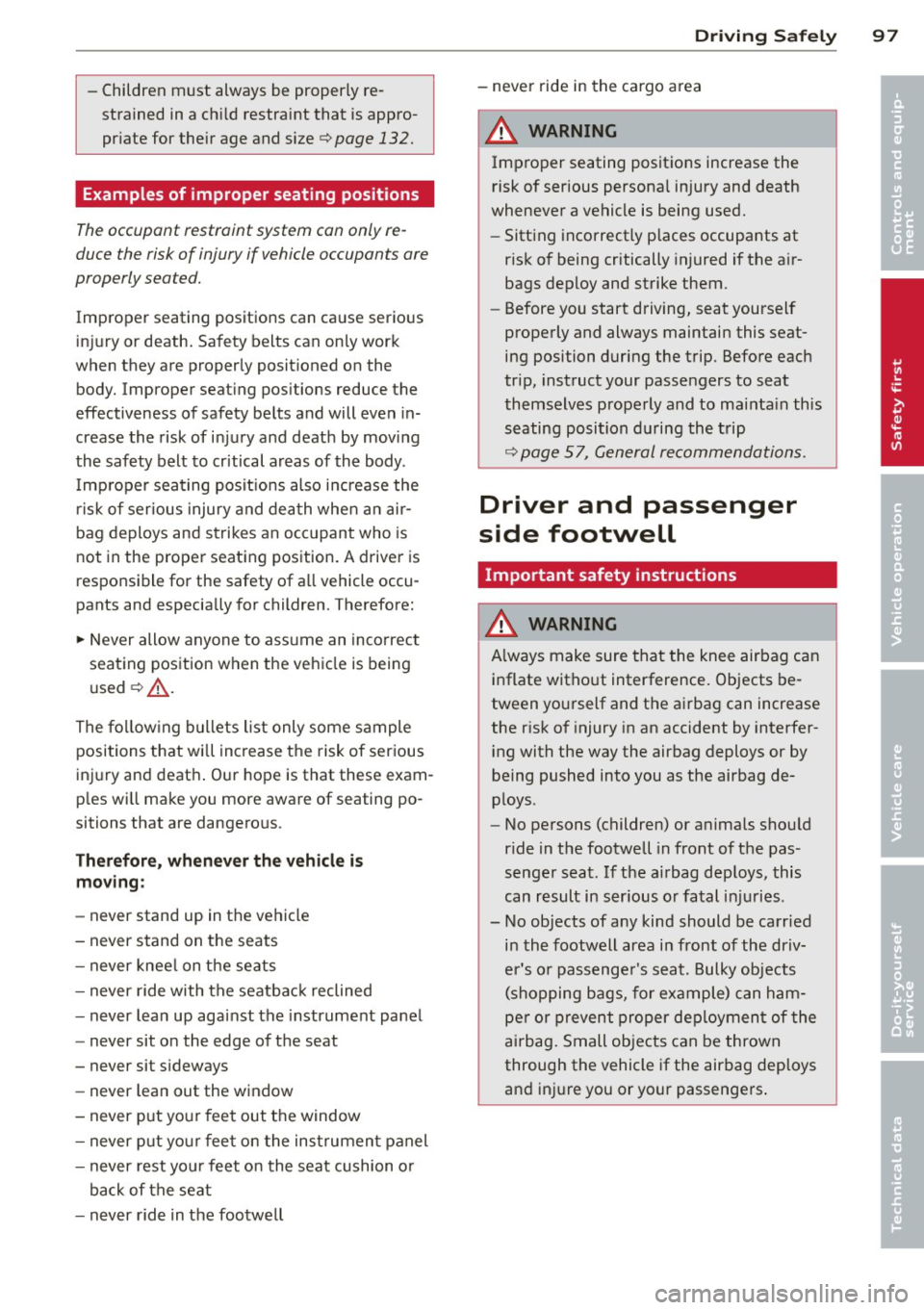
-Children must always be properly re
strained in a child restraint that is appro
priate for their age and size
c:> page 132.
Examples of improper seating positions
The occupant restraint system can only re
duce the risk of injury if vehicle occupants are
properly seated.
Improper seating positions can cause serious
injury or death. Safety belts can only work
when they are properly positioned on the
body. Improper seating positions reduce the
effectiveness of safety belts and will even in
crease the risk of injury and death by moving
the safety belt to critical areas of the body .
Improper seating positions also increase the
risk of serious injury and death when an air
bag deploys and strikes an occupant who is
not in the proper seating position. A driver is
responsible for the safety of all vehicle occu
pants and especially for children. Therefore:
.,. Never allow anyone to assume an incorrect
seating position when the vehicle is being
used
c:> ,&. .
The following bullets list only some sample
positions that wi ll increase the risk of serious
injury and death . Our hope is that these exam
ples will make you more aware of seating po
sitions that are dangerous.
Therefore, whenever the vehicle is
moving:
- never stand up in the vehicle
- never stand on the seats
- never kneel on the seats
- never ride with the seatback reclined
- never lean up against the instrument panel
- never sit on the edge of the seat
- never sit sideways
- never lean out the window
- never put your feet out the window
- never put your feet on the instrument panel
- never rest your feet on the seat cushion or
back of the seat
- never ride in the footwell
Driving Safely 97
-never ride in the cargo area
A WARNING
Improper seating positions increase the
risk of serious personal injury and death
whenever a vehicle is being used.
- Sitting incorrectly places occupants at
risk of being critically injured if the air
bags deploy and strike them.
- Before you start driving, seat yourself
properly and always maintain this seat
ing position during the trip. Before each
trip, instruct your passengers to seat
themselves properly and to maintain this
seating position during the trip
c:> page 57, General recommendations .
Driver and passenger
side footwell
Important safety instructions
A WARNING
A lways make sure that the knee airbag can
inflate without interference. Objects be
tween yourself and the airbag can increase
the risk of injury in an accident by interfer
ing with the way the airbag deploys or by
being pushed into you as the airbag de
ploys .
- No persons (children) or animals should
ride in the footwell in front of the pas
senger seat . If the airbag deploys, this
can result in serious or fatal injuries.
- No objects of any kind should be carried
in the footwell area in front of the driv
er 's or passenger's seat. Bulky objects
(shopping bags, for example) can ham
per or prevent proper deployment of the
airbag. Small objects can be thrown
through the vehicle if the airbag deploys
and injure you or your passengers .
•
•
-
Page 105 of 244
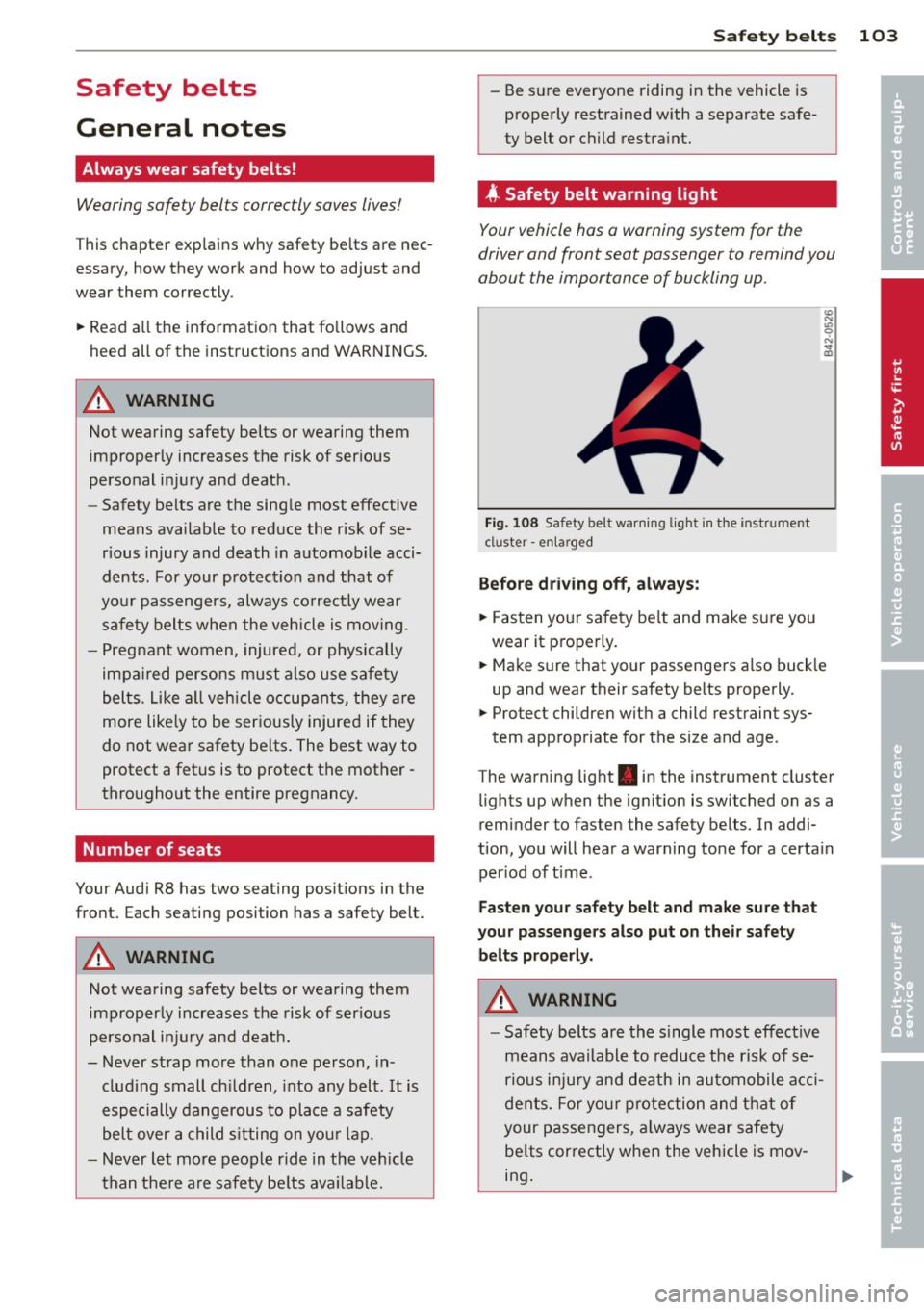
Safety belts
General notes
Always wear safety belts!
Wearing safety belts correctly saves lives!
This chapte r exp lains why safety be lts a re nec
essary, how they work and how to adjust and
wear them correctly.
~ Read a ll the informat ion that fo llows and
heed all of the inst ruct ions and WARNINGS.
A WARNING
Not wearing safety belts or wearing them
improperly increases the risk of ser ious
personal in jury and death .
- Safety belts are the sing le most effective
means availab le to red uce the r isk of se
rious injury and death in a utomob ile acci
de nts . For your prot ecti on and that of
yo ur passenge rs, always co rrec tly wear
sa fe ty bel ts when the ve hicle is mov ing.
- P re g nant women, injured, or physically
imp aired perso ns must also use safe ty
belts. L ike a ll vehicle occup ants, they are
more like ly to be ser ious ly injure d if they
do not wea r safety be lts . The best way to
protect a fet us is to protect the mother -
thro ughout the entire pregnancy.
Number of seats
Your Audi R8 has two seating posit ions in the
front. Each seating position has a safety belt.
A WARNING
Not wearing safety belts or wearing them
im proper ly increases the risk of ser ious
personal in ju ry and death.
- Never st rap more than one person, in
clu ding small ch ild ren, into any belt. It is
especially dangerous to place a safety
belt over a child s itting on yo ur lap.
- Never let mo re people ride in the ve hicle
t h an t he re are safety be lts ava ilable.
Sa fety belts 103
- Be s ure everyone riding in the vehicle is
properly restrained w ith a separate sa fe
ty belt or child restra int.
4 Safety belt warning light
Your vehicle has a warning system for the
driver and front seat passenger to remind you
about the importance of buckling up .
Fig. 1 08 Safety be lt warn ing lig ht in the instr ume nt
cl uster -enla rged
Befor e driv ing off, always :
~ Fasten your sa fe ty belt and make su re you
wear it p roperly.
~ Make s ure that yo ur passenge rs a lso buck le
up and wear their safety belts properly.
~ Protect children with a child rest raint sys-
tem appropriate for the size and age .
The wa rning light . in the inst rument cluster
li ghts up w hen t he ig nit ion is switched on as a
remi nder to fasten the safety belts. In addi
tion , you will hear a warning tone for a certa in
per iod of t ime .
Fasten your safety belt and make sure that
your passengers also put on the ir safety
belts proper ly.
A WARNING
- Safety b elts are the s ingle most effect ive
means ava ilable to reduce t he risk of se
r io us inju ry and death in au tomobile a cci
dents. Fo r yo ur protecti on and tha t of
your passengers, a lways wear safety
be lts cor rectly when the vehicle is mov
ing . •
•
Page 107 of 244
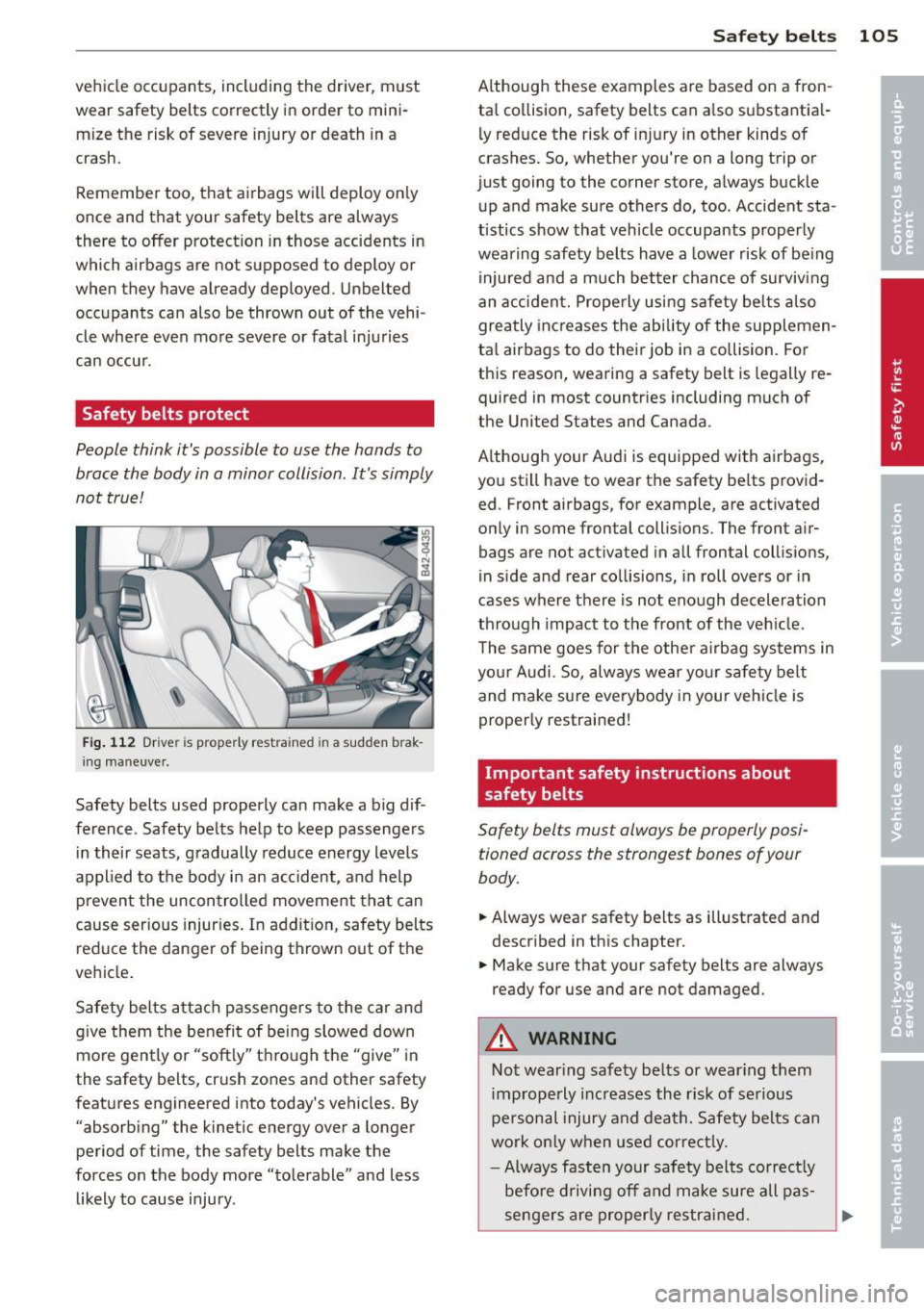
vehicle occupants, including the driver, must
wear safety belts correctly in order to mini
mize the risk of severe injury or death in a
crash.
Remember too, that airbags will deploy on ly
once and that your safety belts are always
there to offer protection in those accidents in
which airbags are not supposed to deploy or
when they have already deployed . Unbelted
occupants can also be thrown out of the vehi
cle where even more severe or fatal injuries
can occur .
Safety belts protect
People think it's possible to use the hands to
brace the body in a minor collision . It's simply
not true!
Fig. 112 Drive r is properly restrained in a sudden b rak
ing maneuve r.
Safety belts used properly can make a big dif
ference . Safety belts help to keep passengers
in their seats, gradually reduce energy levels
applied to the body in an accident, and help
prevent the uncontrolled movement that can
cause serious injuries. In addition, safety belts
reduce the danger of being thrown out of the
vehicle.
Safety belts attach passengers to the car and
give them the benefit of being slowed down
more gently or "softly" through the "give" in
the safety belts, crush zones and other safety
features engineered into today's vehicles . By
"absorbing" the kinetic energy over a longer
period of time, the safety belts make the
forces on the body more "tolerable" and less
likely to cause injury.
Safety belts 105
Although these examples are based on a fron
tal collision, safety belts can also su bsta ntia l
ly reduce the risk of injury in other kinds of
crashes. So, whether you're on a long trip or
just going to the corner store, always buckle up and make sure others do, too . Accident sta
tistics show that vehicle occupants properly
wearing safety belts have a lower risk of being
injured and a much better chance of surviving
an accident. Properly using safety belts also
greatly increases the ability of the supplemen
tal airbags to do their job in a collision. For
this reason, wearing a safety belt is legally re
quired in most countries including much of
the United States and Canada.
Although your Audi is equipped with airbags,
you still have to wear the safety belts provid
ed . Front airbags, for example, are activated
only in some frontal collisions . The front air
bags are not activated in all frontal collisions,
in side and rear collisions, in roll overs or in
cases where there is not enough deceleration
through impact to the front of the vehicle.
The same goes for the other airbag systems in
your Audi. So, always wear your safety belt
and make sure everybody in your vehicle is
properly restrained!
Important safety instructions about
safety belts
Safety belts must always be properly posi
tioned across the strongest bones of your
body.
.,. Always wear safety belts as illustrated and
described in this chapter.
.,. Make sure that your safety belts are always
ready for use and are not damaged.
A WARNING
Not wearing safety belts or wear ing them
improperly increases the risk of serious
personal injury and death. Safety belts can
work only when used correctly.
- Always fasten your safety belts correctly
before driving
off and make sure all pas-
sengers are properly restrained. .,.
Page 109 of 244
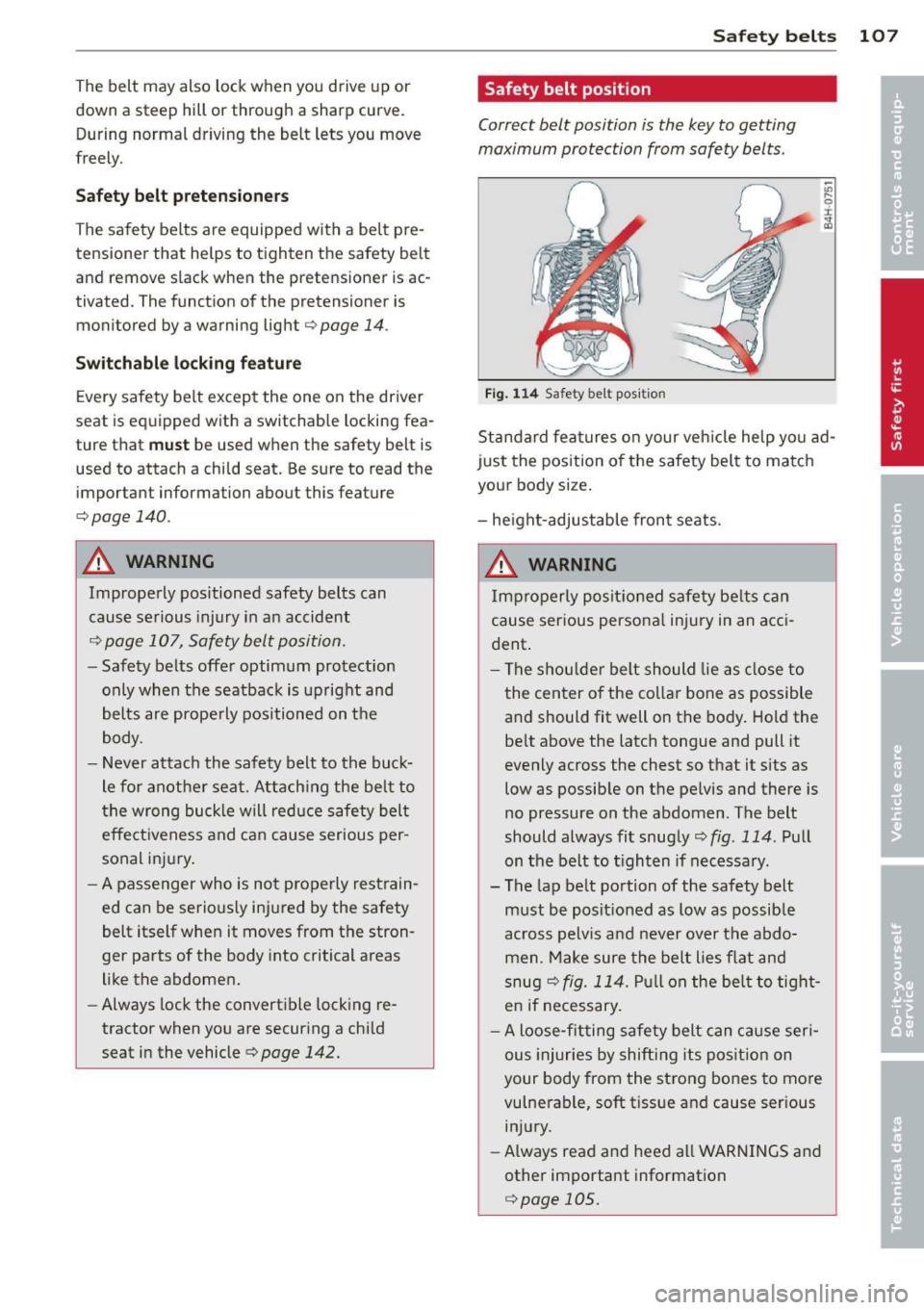
The belt may also lock when you drive up or
down a steep hill or through a sharp curve.
During normal driving the belt lets you move
freely .
Safety be lt pretensioners
The safety belts are equipped with a belt pre
tensioner that helps to tighten the safety belt
and remove slack when the pretensioner is ac
tivated . The function of the pretensione r is
monitored by a warning light ¢
page 14.
Switchable locking feature
Every safety belt except the one on the driver
seat is equipped with a switchable locking fea
ture that
must be used when the safety belt is
used to attach a child seat. Be sure to read the important information about this feature
¢page 140.
A WARNING
Improperly positioned safety belts can
cause serious injury in an accident
¢ page 107, Safety belt position .
-Safety belts offer optimum protection
only when the seatback is upright and
belts are properly positioned on the
body.
-
- Never attach the safety belt to the buck
le for another seat. Attaching the belt to
the wrong buckle will reduce safety belt
effect iveness and can cause serious per
sonal injury.
- A passenger who is not properly restrain
ed can be seriously injured by the safety
belt itself when it moves from the stron
ger parts of the body into critical areas
like the abdomen.
- Always lock the convertible locking re
tractor when you are securing a child
seat in the vehicle
r:::> page 142.
Safety belts 107
Safety belt position
Correct belt position is the key to getting
maximum protection from safety belts .
Fig. 114 Safety belt position
;;;
9 r ., a,
Standard features on your vehicle help you ad
just the position of the safety belt to match
your body size.
- height-adjustable front seats.
A WARNING
Improperly positioned safety belts can
cause serious personal injury in an acci
dent.
-
- The shoulder belt should lie as close to
the center of the collar bone as possible
and should fit well on the body. Hold the
belt above the latch tongue and pull it
evenly across the chest so that it sits as
low as possible on the pelvis and there is
no pressure on the abdomen . The belt
should always fit snugly
r:::> fig . 114. Pull
on the belt to tighten if necessary.
- The lap belt portion of the safety belt
must be positioned as low as possible
across pelvis and never over the abdo
men . Make sure the belt lies flat and
snug ¢
fig. 114. Pull on the belt to tight
en if necessary.
- A loose-fitting safety belt can cause seri
ous injuries by shifting its position on
your body from the strong bones to more
vulnerable, soft tissue and cause serious injury.
- Always read and heed all WARNINGS and
other important information
r:::> page 105.
Page 114 of 244
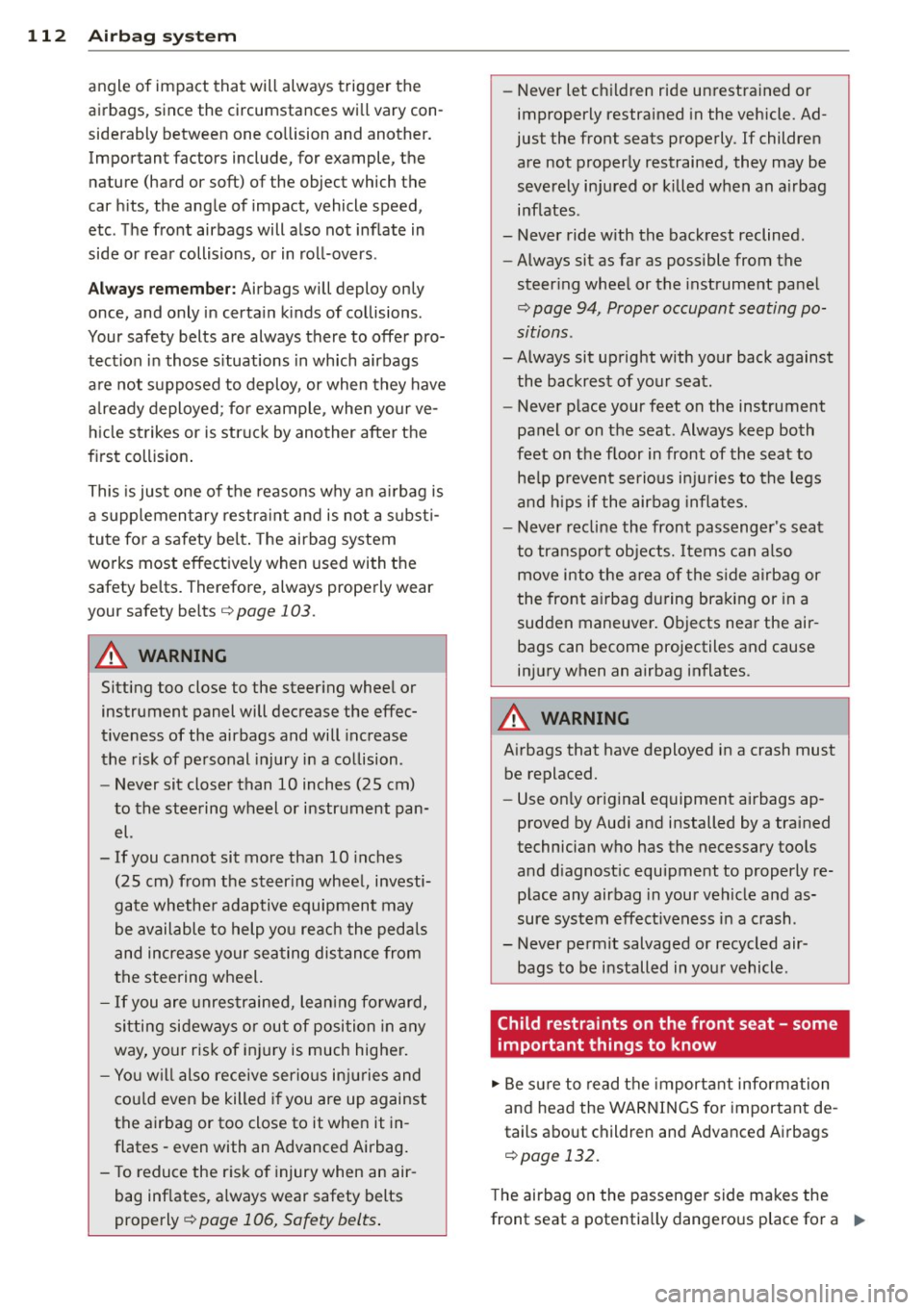
112 Airbag system
angle of impact that will always trigger the
airbags, since the circumstances will vary con
siderably between one collision and another.
Important factors include, for example, the
nature (hard or soft) of the object which the
car hits, the angle of impact, vehicle speed,
etc. The front airbags will also not inflate in
side or rear collisions, or in roll-overs.
Always remember: Airbags will deploy only
once, and only in certain kinds of collisions .
Your safety belts are always there to offer pro
tection in those situations in which airbags
are not supposed to deploy , or when they have
already deployed; for example , when your ve
hicle strikes or is struck by another after the
first collision.
This is just one of the reasons why an airbag is
a supplementary restraint and is not a substi
tute for a safety belt. The airbag system
works most effectively when used with the
safety belts. Therefore, always properly wear
you r safety belts¢
page 103 .
A WARNING
Sitting too close to the steering wheel or
instrument panel will decrease the effec
tiveness of the airbags and will increase
the risk of personal injury in a collision .
- Never sit closer than 10 inches (25 cm)
to the steering wheel or instrument pan el.
- If you cannot sit more than 10 inches
(25 cm) from the steering wheel, investi
gate whether adaptive equipment may
be available to help you reach the pedals
and increase your seating distance from
the steering wheel.
- If you are unrestrained, leaning forward,
sitting sideways or out of position in any
way, your risk of injury is much higher.
- You will also receive serious injuries and
could even be killed if you are up against
the airbag or too close to it when it in
flates -even with an Advanced Airbag.
- To reduce the risk of injury when an air
bag inflates, always wear safety belts
properly
c::> page 106, Safety belts.
- Never let children ride unrestrained or
improperly restrained in the vehicle. Ad
just the front seats properly . If children
are not properly restrained, they may be
severely injured or killed when an airbag
inflates .
- Never ride with the backrest reclined.
- Always sit as far as possible from the
steering wheel or the instrument panel
¢ page 94, Proper occupant seating po
sitions .
-Always sit upright with your back against
the backrest of your seat.
- Never place your feet on the instrument
panel or on the seat. Always keep both
feet on the floor in front of the seat to
help prevent serious injuries to the legs
and hips if the airbag inflates.
- Never recline the front passenger's seat
to transport objects. Items can also
move into the area of the side airbag or
the front airbag during braking or in a
sudden maneuver. Objects near the air
bags can become projectiles and cause
injury when an airbag inflates.
A WARNING
-Airbags that have deployed in a crash must be replaced.
- Use only original equipment airbags ap
proved by Audi and installed by a trained
technician who has the necessary tools
and diagnostic equipment to properly re
place any airbag in your vehicle and as
sure system effectiveness in a crash .
- Never permit salvaged or recycled air
bags to be installed in your vehicle .
Child restraints on the front seat - some
important things to know
.,. Be sure to read the important information
and head the WARNINGS for important de
tails about children and Advanced Airbags
c::> page 132.
The airbag on the passenger side makes the
front seat a potentially dangerous place for a ..,_
Page 115 of 244
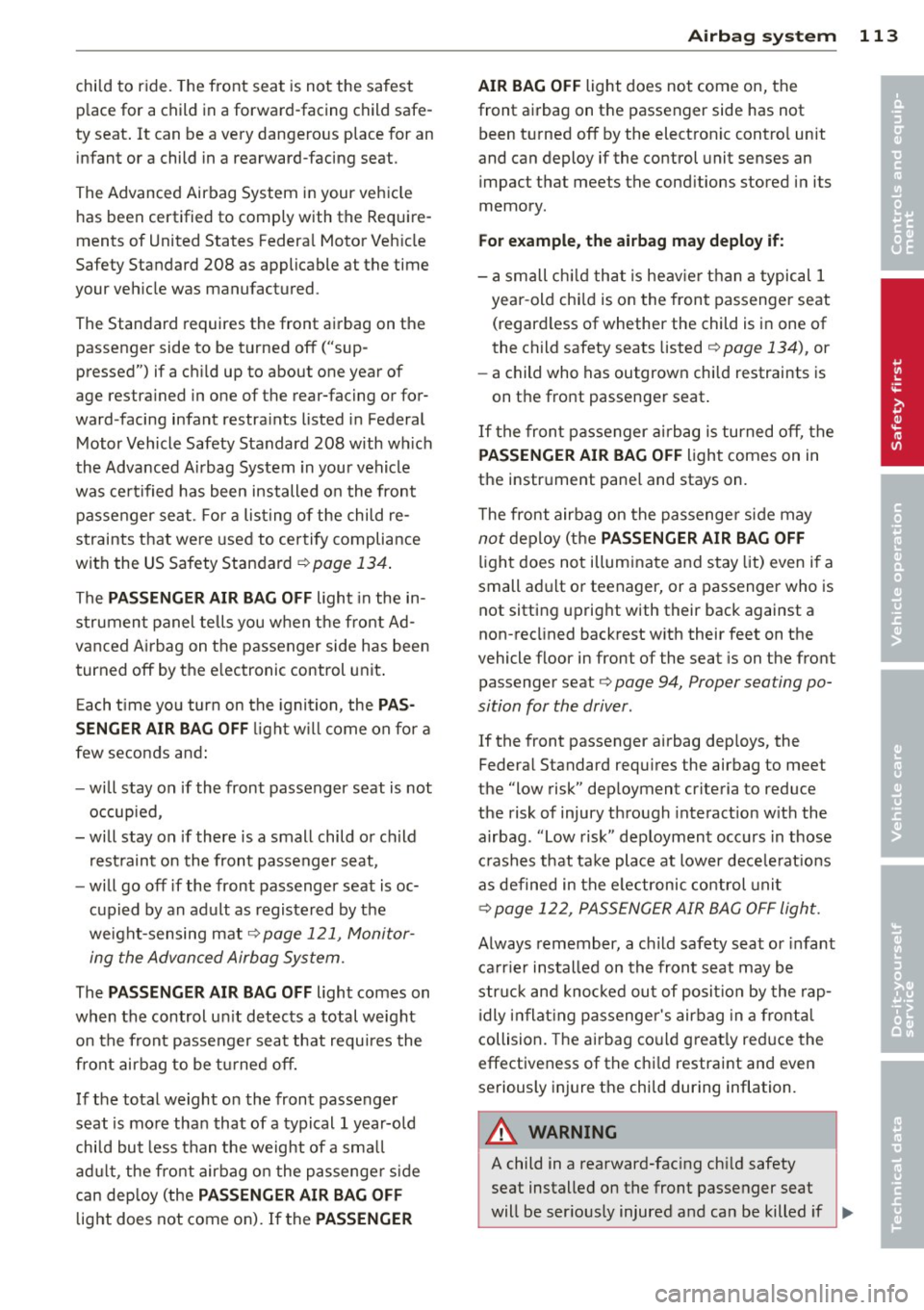
child to ride. The front seat is not the safest
p lace for a child in a forward-facing child safe
ty seat . It can be a very dangerous place for an
infant or a child in a rearward-facing seat.
The Advanced Airbag System in your vehicle has been certified to comply with the Require
ments of United States Federa l Motor Veh icle
Safety Standard 208 as applicable at the time
your veh icle was manufactured.
The Standard requires the front airbag on the passenger side to be turned off ("sup
pressed") if a ch ild up to about one year of
age restra ined in one of the rear-facing or for
ward-facing infant restra ints listed in Federal
Motor Vehicle Safety Standard 208 with w hich
the Advanced Ai rbag System in your vehicle
was certified has been installed o n the front
passenger seat. For a list ing of the child re
straints that were used to certify compliance
with the US Safety Standard
r::tv page 134 .
The PASSENGER AIR BAG OFF light in the in
s trument panel te lls you when the front Ad
vanced Airbag on the passenger side has bee n
turned off by the e lectronic control unit .
E ach t ime yo u tur n on the ignition, the
PAS
SENGER AIR BAG OFF
li ght w ill come on for a
few seconds and :
- will stay on if the front passenger seat is not
occup ied,
- will stay on if there is a small child o r child
rest raint on the front passenger seat,
- will go off if the front passenger seat is oc
cup ied by an adult as registe red by the
weight-sensing mat
r::tv page 121, Monitor
ing the Advanced Airbag System.
The PASSENGER AIR BAG OFF light comes on
when the control un it detects a total weight
on the front passenger sea t that requires the
fr ont airbag to be tu rned off.
If the total we ight on the front passenger
seat is mo re than that of a typical 1 year-o ld
child but less than the weight of a sma ll
ad ult, the front airbag o n the passenge r side
can dep loy (the
PASSENGER AIR BAG OFF
lig ht does not come on). If the PASSENGER
A irbag system 113
AIR BAG OFF light does not come on, the
front airbag on the passenger side has not been t urned off by the elect ronic contro l un it
and can deploy if the control unit senses an
impact that meets the cond itions stored in its
memory .
For example , the airb ag may deplo y if:
-a small ch ild tha t is heav ier t han a typical 1
year -old chi ld is on the fron t passenger seat
(regard less of whether the child is i n one of
the child safety seats listed
r:!> page 134), or
- a child who has outgrown chi ld restraints is
on the front passenger seat .
If the fron t passenger a irbag is turned off, the
PA SS ENGER AIR BAG OFF light comes on in
the instr ument pane l and stays on.
T he front airbag on the passenge r side may
not deploy (the PASSENGER AIR BAG OFF
light does not illum ina te a nd stay lit) even i f a
small ad ult o r teenager, or a passenger who is
not sitting uprig ht with their back against a
non-recl ined backrest w ith their feet on the
vehicle floor in front of the seat is on the front
passenger seat
r:!> page 94, Proper seating po
sition for the driver .
If the front passenger airbag dep loys, the
Federa l Standard requ ires the airbag to meet
the "low risk" dep loyment criteria to reduce
the risk of injury th rough interact ion w ith the
a irbag . "Low risk" dep loymen t occ urs in those
c rashes that ta ke place at lower dece le rat ions
as defined in the e lectronic control unit
r::tv page 1 22, PASSENGER AIR BAG O FF ligh t.
Always remember, a c hild safety seat or infant
ca rr ie r installed on the front seat may be
stru ck and knoc ked ou t of po sit io n by the rap
idly i nflat ing passenger 's airbag in a front al
collision. The ai rbag co uld g reat ly reduce the
effectiveness of the chi ld restrai nt and even
seriously injure the child during inflation.
A WARNING
A child in a rearward-fac ing ch ild safety
seat installed on the front passenger seat
-
will be ser ious ly injured and can be killed if .,.. •
•
Page 116 of 244
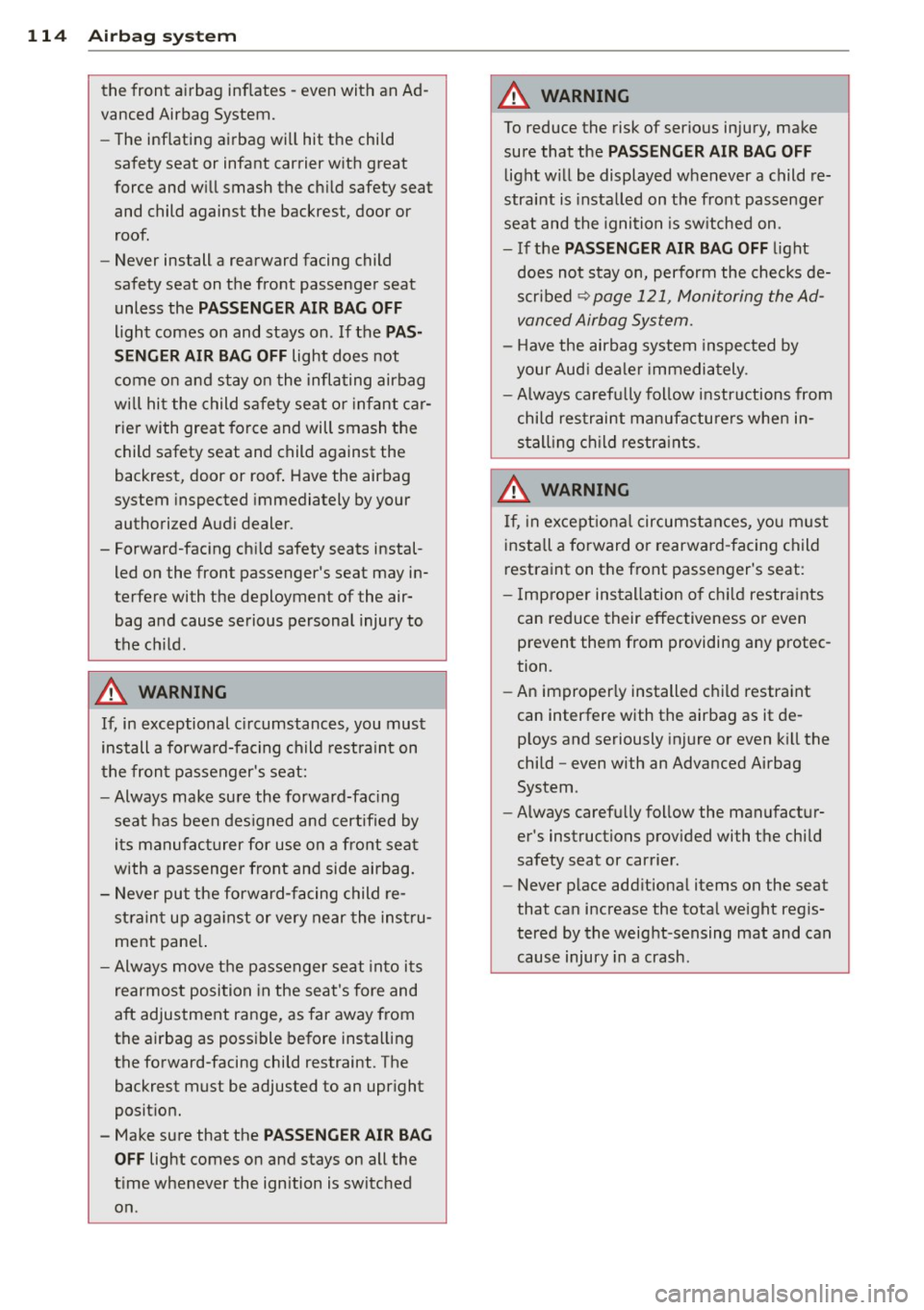
114 Airbag sys te m
the front airbag inf lates -even with an Ad
vanced Airbag System.
- The inflating airbag will hit the child
safety seat or infant carrier with great
force and w ill smash the ch ild safety seat
and child against the backrest, door or
roof.
- Never install a rearward facing child
safety seat on the front passenge r seat
unless the
PASSENGER AIR BAG OFF
light comes on and stays on . If the PAS
SENGER AIR BAG OFF
light does not
come on and stay on the infla ting airbag
wi ll hi t the child safe ty seat or infant car
rie r with great force and will smash the
child safety seat and child against the
backrest, door or roof . Have the airbag
system inspected immediately by your
authorized Audi dealer .
- Forward-fac ing ch ild safety seats instal
led on the front passenger's seat may in
terfere with the deployment of the air
bag and cause serious personal injury to
the ch ild.
A WARNING
If, in exceptional c ircumstances, you must
install a forwa rd-facing child restra int on
t he fron t passenger's seat:
- Always make sure the forward-fac ing
sea t has been des igned and certified by
i t s manufac turer for use on a fro nt sea t
with a passenger front an d side airbag.
- Never put the forwa rd-f acing child re
s t rain t up aga inst or very near the inst ru
ment pane l.
- Always move t he passenger seat into i ts
rearmost position in the seat 's fore and
aft adjustment ran ge, as far away from
the a irbag as poss ible before installing
the forward-facing child restraint . The
backrest must be adjusted to an upr ight
posit ion.
- Make sure that the
PASSENGER AIR BAG
OFF
light comes on and stays on all the
t ime whenever the ignition is switched
on .
A WARNING
To reduce the risk of serious injury, make
sure that the
PASSENGER AIR BAG OFF
light w ill be displayed whenever a child re
straint is insta lled on the front passenger
sea t and the igni tion is sw itched on .
- If the
PASSENGER AIR BAG OFF light
does not stay on, perform the checks de
s cri bed
~ page 121, Monitoring the Ad
vanced Airbag System.
- Have the airbag system inspected by
your Aud i dea le r i mmedia tely .
- Always carefu lly follow instr uctions from
child res tra in t manufacture rs whe n in
s tall ing c hild restr aints .
A WARNING
If, in except iona l circumst ances, yo u m ust
i nst all a forward or rearwa rd -f acing child
r estraint on t he front passenger's seat :
- I mp roper ins tallation o f ch ild restra ints
can reduce their effectiveness o r even
prevent them from providing any protec
tion .
- An improper ly installed c hild restra int
can interfere with the airbag as it de p loys and seriously injure or even k ill the
child -even with an Advanced Airbag
System .
- Always carefully follow the manufactur
er 's instructions prov ided with the chi ld
safety seat or carrier .
- Never p lace add itiona l items on the seat
that ca n increase the total weight reg is
tered by the weig ht-sensing mat and can
cause injury in a crash.
Page 117 of 244
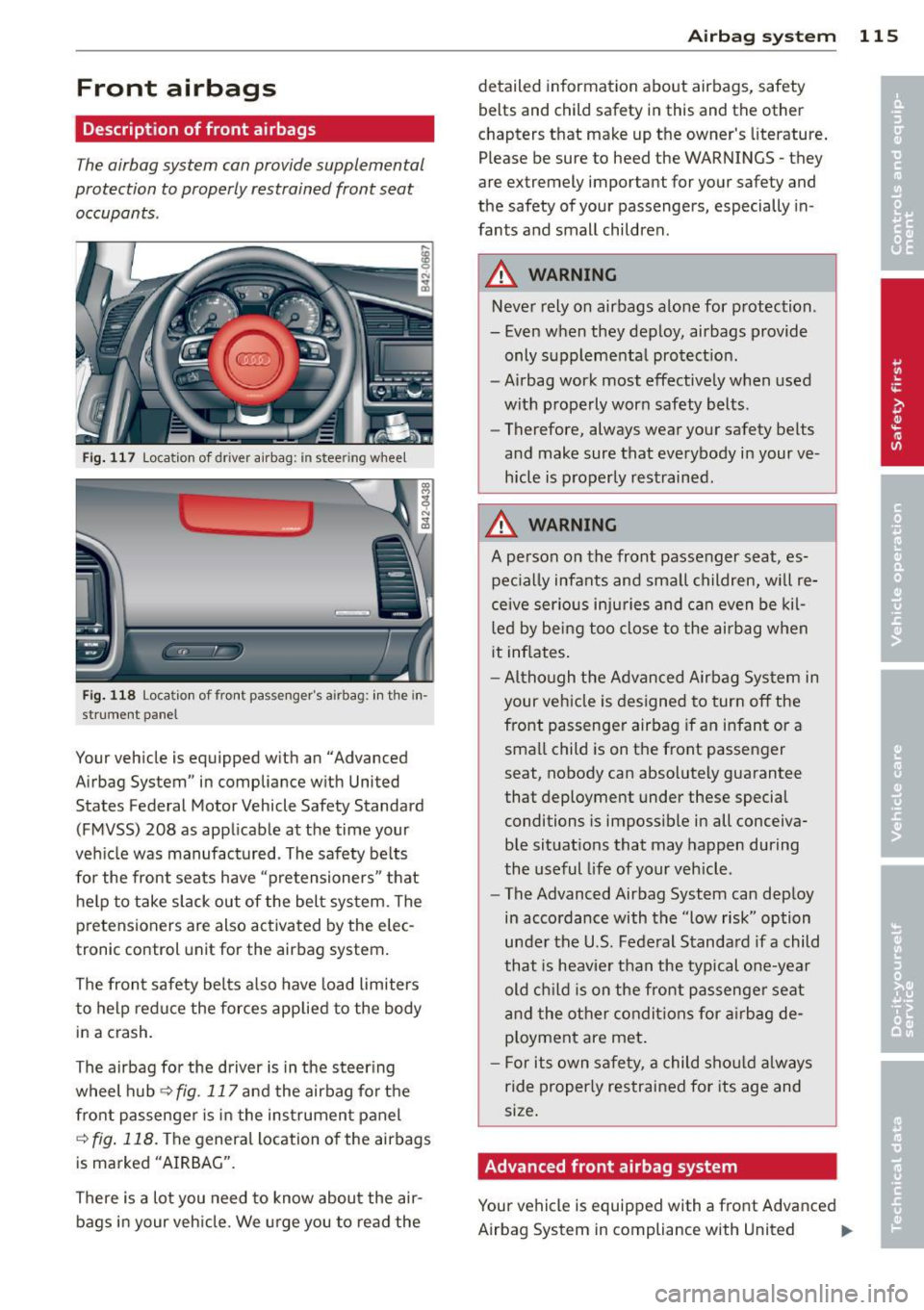
Front airbags
Description of front airbags
The airbag system can provide supplemental
protection to properly restrained front seat
occupants .
Fig. 117 Loca tion of driver airbag: in steering whee l
Fig. 118 Locatio n of front passe nger 's ai rb ag : in th e in
st rument panel
Your vehicle is equipped with an "Advanced
Airbag System" in compliance w ith United
States Federal Motor Vehicle Safety Standard
(FMVSS) 208 as app licable at the time your
veh icle was manufactured . The safety be lts
fo r the front seats have "pretensioners" that
h e lp to take s lack out of the belt system. The
pretensioners are also activated by the elec
tronic control unit for the airbag system.
The fron t safety belts a lso have load limiters
to help reduce the forces applied to the body
in a crash.
The airbag for the driver is in the steer ing
wheel hub¢
fig. 117 and the airbag for the
fro nt passenger is in the instrumen t panel
¢ fig . 118. The genera l location of the airbags
is marked "AIRBAG".
There is a lot you need to know about the air
b ags in your veh icle. We urge you to read the
A irba g sy stem 115
detailed information about airbags, safety
belts and child safety in this and the other
chapters t hat make up t he owner's literature .
Please be sure to heed the WARNINGS - they
are extremely important for your safety and
the safety of your passengers, especially in
fants and small child ren.
A WARNING ,.;;
Neve r rely on airbags alone for protection .
- Even when they deploy, airbags provide
only s upplementa l protect ion.
- Airbag work most effective ly when used
with properly wor n safety belts.
- Therefore, always wear your safety belts
and make sure that everybody in your ve
hicle is p roperly restrained.
A WARNING
A person on the front passenger seat, es
pec ia lly infants and sma ll children, will re
ceive serious i njuries and can even be kil
l ed by being too close to the ai rbag when
it inflates .
- Al tho ugh the A dvanced Airbag Sys tem in
your veh icle is designed to tur n off the
front passenger airbag if an infant or a
sma ll child is on t he front passenger
seat, nobody can absolutely guarantee
that deployment under these special
conditions is imposs ible in all conceiva
ble situat ions that may happen during
the useful life of your veh icle .
- The Advanced Airbag System can dep loy
in acco rdance with the "low risk" option
unde r the U .S. Fede ral Standa rd if a child
that is heav ie r than the typical one-year
old c hild is on the front pas senge r seat
and the other condi tions for airbag de
p loyment are met .
- For its own safe ty, a c hild sho uld always
ride proper ly restrained for its age and
size .
Advanced front airbag system
-
Your vehicle is equipped with a front Advanced
Airbag System in compliance with United
Ill>